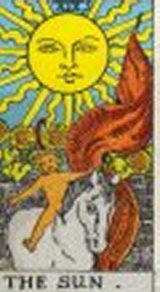History of The Tarot

The invention of the Tarot cards has been attributed to various sources. Some have seen in the word "tarot" a corruption of the name Thoth, the ancient Egyptian god of magic, reinforcing the legend that the cards were created in the initiation temples of the mysterious East. Their invention has also been attributed to the Order of the Knights Templar, an ascetic military Order founded in 1188 to protect pilgrims and guard the routes to the Holy Land.
Whatever the rumors about their appearance, the Tarot is closely linked with our modern deck of playing cards. It is generally accepted by scholars that the earliest playing cards originated in China and Korea, dating back at least to the 11th century.
If Tarot cards, as seems most likely, were devised originally somewhere in Northern Italy, it can be surmised that their makers were perhaps inspired by oriental cards brought from the east by merchants returning to the great trading port of Venice. The original 78-card Tarot pack is generally referred to in Italy as the Venetian or Peidmontese Pack, to differentiate it from later offshoots.
The Tarot Reading
The Tarot is a deck of 78 picture cards that has been used for centuries to reveal hidden truths. In the past few years, interest in tarot has grown tremendously, as more and more people seek extra insight and answers to their problems.
A reading consists of shuffling the deck, drawing a set number of cards at random, arranging them in a pattern or spread, and interpreting the symbols in relation to the past, present and future. A question or current life influence may be considered in the light of the drawn cards. When Tarot cards are placed in groups and patterns, the complexity of their meaning is multiplied and takes on specific interpretations that can be applied to situations in life. The tarot cards are deceptively simple, but surprisingly rich.
Tarot's strengths are an ability to pick up on people through the intuitive skills of the person doing the reading, but subjects must have the ability to recognize and utilize information as it applies to everyday life.
Tarot is a kind of mirror for the mind. It allows hidden psychic currents to express themselves to our awareness.
How the Tarot is Structured
There are 78 cards in the deck, which is divided into two parts: the Major Arcana and the Minor Arcana. The word "arcana" means mysteries or secrets. The Minor Arcana consists of 56 cards divided into four suits, each suit having ten Pip cards and four Court cards. Apart from the extra Court card in each suit (the Knight), the Minor Arcana resembles a pack of modern playing cares, but the suits have different names: Wands, Rods or Batons (corresponding to Clubs); Cups (corresponding to Hearts); Swords (corresponding to Spades); and Coins, Pentacles or Discs (corresponding to Diamonds). Court cards are usually called King, Queen, Knight and Page.
The 22 cards of the Major Arcana form a sequence of 21 numbered cards, plus one unnumbered card called the Fool, which is sometimes numbered zero. Each of the Major Arcana cards depicts a strange scene which appears to tell a story or convey a message. Each card is appropriately titled - the Sun, the Lovers, the Tower, the Hanged Man, Justice, the Emperor, the Star, the Chariot, to name but a few. There is a specific order to the Major Arcana cards, but you may notice that some decks deviate from this. The cards of Justice and Strength are most commonly transposed, this occurring, for example, in the popular Rider-Waite Tarot
deck.
Home
About Us
Tarot Readings
Psychic Readings
Runes Readings
Dreams
Numerology Readings
Free Reading
Our Services & Fees
Purchase
Email Order Form
Contact Us
Feedback Form
Guestbook
@Copyright White Feather 2006



